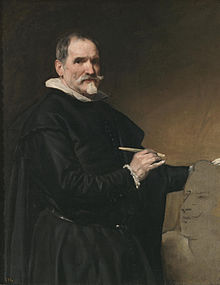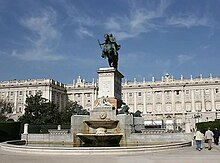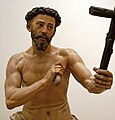Juan Martínez Montañés

Juan Martínez Montañés (christened on 16th March 1568 in Alcalá la Real , † 18th June 1649 in Seville ) was a Spanish sculptor of the Baroque . He is considered the most important representative of polychrome sculpture in Spain's Siglo de Oro . In the Paragone he spoke out in favor of the supremacy of sculpture over painting, which was then still subordinate.
Life
Martínez Montañés was born and raised in Alcalá la Real in Andalusia as the son of Juan Martínez and Marta González. In 1579 or 1580 he began training as a sculptor with Pablo de Rojas in Granada . He worked most of his life in Seville, where he probably first stayed in 1582. In 1587 he married Ana de Villegas, presumably 16 years old, with whom he had five children (these were: Sister Mariana de San Augustín, Dominican; Bernardino Martínez Montañés, Franciscan; José Martínez de Iniesta, presbyter ; as well as Rodrigo Martínez and Catalina de Villegas ). In Seville he made the acquaintance of Diego Velázquez and his teacher Francisco Pacheco del Río early on while carrying out artistic commissions . In 1588 he passed an exam before the church building supervisors ( Alcaldes Veedores de Escultores y Entalladores ) Gaspar del Aguila and Miguel Adán.
On August 2 or 3, 1591, Martínez Montañés was involved in a murder and spent two years in prison until, after paying compensation to the widow of a certain Luis Sánchez, her forgiveness. In 1592 he became a member of the brotherhood Cofradía del Dulce Nombre de Jesús . Between 1601 and 1602 he moved into his own houses on Calle de la Muela in the Santa Maria Magdalena district of Seville, previously his changing domicile was in the districts ( collaciones ) San Vicente, Santa Maria Magdalena (Plazuela del Campanario), San Lorenzo (1593 , Arquillo de los Roelas) and El Salvador (1593). In 1607 he was involved in a court case relating to tax payments ( alcabala ).
In 1614 Martínez Montañés married Catalina de Sandoval, with whom he had seven children (these were: Fernando Martínez Montañés de Uzanqui, relator at the Audiencia de Seville; Doña Mariana; Juan Francisco Martínez Montañés, America traveler; Doña Ana Micaela; José Ignacio Fernández; Teresa de Salcedo; and the cleric Hermenegildo).
In 1620 Martínez Montañés documented his Limpieza de sangre , with which he led, at least formally, the evidence that he had no Jewish or Muslim ancestors. In 1621 he got into a conflict with the disadvantaged painters, who threatened to sue the Real Audiencia . From June 1635 he stayed at the royal court in Madrid for seven months , where he made a design for an equestrian statue of Felipe IV (see picture above), for which he received 400 Ducados four years later. The assumption that the presumably unfinished portrait shows the painter Alonso Cano was refuted by Carl Justi .
He received the order to make the bust from Gaspar Guzmán y Pimentel, who was also known as Conde-Duque de Olivares and was considered a favorite ( valido ) of the king. The clay bust was sent to the Florentine sculptor Pietro Tacca on January 23, 1636 , who, using this model, had a technically demanding bronze equestrian statue cast in Italy, because it only rests on the hind legs . After it was disembarked via Livorno , after delays it was erected on October 29, 1642 in the Jardin de la Reina and has stood in the Plaza de Oriente since 1844 .
He worked with wood on which he then applied paint. Martínez Montañés created a number of impressive altars for the Cathedral of Seville and neighboring churches (1607-20). He was characterized by the realistic depiction of the Christ figure. Montañés, the "Spanish Michelangelo" , died on June 18, 1649 of the plague . He had shaped the Sevillian sculpture school and generally art and aesthetics in Seville and thus in the Spanish empire like no other.
Works (selection)
Web links
Individual evidence
- ^ A b Fernando Checa, traduit par Marc Phéline: Vélasquez - Tout l'œuvre peint . Éditions Ludion, Bruxelles 2008, ISBN 978-90-5544-745-9 , p. 123 .
- ↑ a b c d José Hernandez Diaz: Juan Martínez Montañés (1568–1649) . Guadalquivir SL Ediciones / Fundación Fondo de Cultura de Sevilla (FOCUS), Sevilla 1987, ISBN 84-86080-04-5 , p. 19 .
- ↑ a b c d e f g h Tomaso Montanari : Vélasquez et l'art du portrait baroque . In: Francis Morel (ed.): Les grands maîtres de l'art . No. 6 . Le Figaro, Paris 2008, ISBN 978-2-8105-0005-5 , pp. 221–224 (première parution 2008 aux éditions E-ducation.it S. p. A. Firenze; traduit par CIEL (Center international d'études linguistiques, Paris)).
- ↑ José Fernández López, et al .: Andalucía Barroca (catálogo) . Ed .: Alfonso Pleguezuelo, Enrique Valdivieso. Junta de Andalucía - Consejería de Cultura, 2007, ISBN 978-84-8266-764-5 , pp. 154 .
| personal data | |
|---|---|
| SURNAME | Martínez Montañés, Juan |
| BRIEF DESCRIPTION | Spanish sculptor |
| DATE OF BIRTH | March 16, 1568 |
| PLACE OF BIRTH | Alcalá la Real |
| DATE OF DEATH | June 18, 1649 |
| Place of death | Seville |







